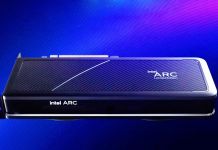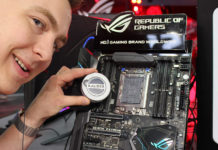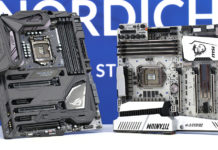ABIT Fatal1ty AN8 SLI is a mainboard geared towards enthusiasts, gamers and overclockers. Who would be more fitting to take a closer look at Abit’s new flagship than the current Swedish overlocking champion.
Abit’s entrance on AMD’s socket 939 platform can be described as hesitant. While other manufactures were quick to release motherboard based on partly VIA’s K8T890 chipset and nVIDIA´s nForce 4 chipset there were non from Abit. At the end of 2004 Abit did release two motherboards with these circuits, the AX8 (K8T890) and AN8 (NF4). Many expected a high performance motherboard based on NF4 mainly because they had waited with the release. The result was nothing more than an ordinary NF4 without any groundbreaking features. Besides, it didn’t even support SLI! What were they thinking?

Probably they were waiting to make their second generation NF4 motherboards perfect, Fatal1ty AN8 SLI and their siblings AN8 SLI and AN8 Ultra. We will now find out if Abit have succeeded with this, and try to find out if this motherboard can be overclocked. Let us start with looking at the specifications on our test board, Fatal1ty AN8 SLI, and finding out if it was worth waiting for.
 | |
Abit Fatal1ty AN8 SLI – Specifications | |
| Processor support | AMD Socket 939 Athlon 64/64FX and Athlon 64 X2 |
| Chipset | NVIDIA NF4 SLI |
| Memory | 4 184-pin DIMM Dual DDR400 channels Max. 4GB |
| Expansion slots | 2 PCI Express x16 2 PCI Express x1 2 PCI 1 AudioMax |
| Storage | 1 Floppy drive 2 Ultra DMA 133/100/66/33 IDE 4 SATA 3G (RAID 0/1/0+1) |
| Internal connections | 3 USB 1 IEEE 1394 |
| External connections | 1 PS/2 Keyboard 1 PS/2 Mouse 1 IEEE 1394 Firewire 4 USB 1 RJ-45 (10/100/1000Mbit) |
| Size | 305 x 245mm |
| Other | µGuru Panel |
| Price | ~1950 SEK ( Exchange rates ) |
As we can see, this motherboard has everything we expect it to have. If we compare it with other manufacturers’ boards at the moment, we find other motherboards with up to eight SATA-ports and double gigabit networks circuit. So this is not a natural choice if you are going to make a file server, but they did not create the Fatal1ty series for that, it was made for gamers, to quote Abit.
Time to check what comes with the board.
The box that Abit Fatal1ty is delivered in is big and approximately twice as thick as an ordinary motherboard carton. Inside every thing is well protected, so you must use a lot of force to damage it.
The three accessories up to the right is a SLI-bridge to put between the graphic cards. SLI-card for activating SLI-mode plus expansion card for audio outputs.
Further more there are four SATA-cables, power cable for two SATA-Hdd, cable to the floppy drive, IDE-cable, a CD with drivers, I/0 bracket, manual and a “quick guide”, and a ingenious little fan to put over the graphic card for instance included.
Some may have frowned and wondered what that mystic control in the picture in the middle above is. That is Abit uGuru panel that gives you an easy access to a lot of different system values like the speed of your fans and frequencies and voltage. There are also two outputs for USB, one for firewire, microphone, headsets and a easy accessible button for clearing the CMOS-memory.
Time to take a look at the actual mainboard.
This motherboard doesn’t have a messy design, they’ve chosen to use red and black, with the exception for IDE-ports. When it comes to the layout of the ports, most of them are where you are used to have them, with a few exceptions on details.
First of all some might have opinions of the placement for the connection to the floppy drive channel, which is placed furthest down in the middle of the motherboard. This placement can give you some problems with other cables in a bigger chassis. On the other hand, you can look at it as we do; there is a connection anyway, just in case. Further more we wonder how the battery will behave with cooling devices that give you temperature below zero due to its proximity to the processor socket. The third is the CPU FAN1 contact that all too often is placed so it ends up underneath the power supply. And besides, we have OTES cooling and another fragile component on each side.
At the bottom to the right we have the most internal connections points. The panel for diodes and on/off switches have clear instructions with color markings, +/- and texts that explain below the buttons. That’s positive when you have misplaced your manual. And right to the left we have a LED-display witch shows post codes. And just above these we find all four SATA-contacts in a row and in their “logic” tradition they have put them in the order 3, 4, 2, 1 from left. Further to the left we have the internal USB- and IEEE1394-connections. The jumper to clear the CMOS is placed on a good place and it is easy to move thanks to the extended plastic, and its easy grip. The place for the SLI-card is placed as usual between the both PCI Express x16-ports.
We continue with a look at how Abit has placed the various components and take a closer look at the different power components on the next page.
The first picture shows a usual molex connection which is located at the bottom of the mainboard, its purpose is to increase power access. The second picture gives an overview for the power supply for the memories. At the first glance it may look as a usual power supply, but it isn’t. Abit is one of the first manufacturers to use the PwM-technology for power supply. Traditionally the power is regulated linearly, which results in a huge loses of energy. PwM stands for Pulse – width – modulation, and it’s the same method that regulates the power to the processors. The downside is that it uses more components like like capacitors and coils, which we can see in picture two. Thanks to this you have a wide range of voltages and even higher, up to 3.40 V in this case. (In BIOS-version before 16 there was a possibility to use up to 3.55 V but they regulated to this lower setting). The last picture gives an oversight of the power supply. Abit has used high quality capacitors and active cooled MOSFETs in their 4-stage power supply. The active cooling is called OTES by Abit, and it stands for Outside Thermal Exhaust System.
Overall we are very satisfied with the layout and the design of this motherboard, and now we only have to take a quick peek in the BIOS before we start the test.
The first screen is familiar to most of us, and disregarding the ”uGuru Utility”, the layout hasn’t changed over the years. This is by no means a disadvantage, seeing as Abit are well-known for making genuine BIOSes that are easy to navigate. Going back a couple generations, they started expanding the functions of the classical BIOS with the micro-Guru technology. One can see that the uGuru part has received its own look and a great deal of functions for controlling fans and adjusting voltages.
| HTT | 200-410MHz |
| Multiplier | 4x-25x (requires an unlocked processor) |
| PCI-Express | 100-145MHz (1MHz steps) |
| Processor voltages | 1.500V-1.850V (0.13u *) 1.400V-1.750V (0.09u *) |
| Memory voltage (vdimm) | 2.50V-3.40V |
| Memory voltage (vtt) | 1.25V-1.75V, or vdimm/2 |
| Northbridge voltage | 1.50V-1.80V |
| HyperTransport voltage | 1.20Vv-1.35V |
| Reference voltage memory | +- 100mV |
| Reference voltage processor | +- 100mV |
As we can see, there aren’t any exceptional settings except the possibility to set vdimm to 3.40V. Some memory works better with a vtt that isn’t 50% of the vdimm (as the specification says), and it’s a good thing that we can adjust it freely. We continue to look at more BIOS settings on the next page.
Under the Advanced Chipset Features are settings for the HT-bus and a generous amount of memory settings.
Further, under the Abit EQ, we have information about temperatures and voltages. The last page gives an overview of all settings that exists for the fans, with the option of setting the rpm’s depending on temperature.
Now it’s time to see what the mainboard can handle, first a little overview of the test system.
Definitions | |
| Idle | One hour in Windows without load |
| Load | One hour with two copies of Prime95 running |
| Stable | No errors reported by Prime during load |
| Processor temperature | The temperature reported by Abit EQ |
We start with checking the mainboard’s capacity to handle overclocking before we continue with some synthetic tests and SLI tests.
With today’s vast selection of memories at different speeds, it is important that the mainboard supports high HT frequencies to maximize the utilization of those speeds. We started our journey up-wards through software in Windows. Surprisingly, we landed at 393 MHz without altering the HT voltage. An increase in the voltage, however, didn’t produce any higher frequencies. These are very good results of which only a few mainboards can achieve. One may wonder what the benefit of such high HT frequencies would be. One advantage is that most processors today have locked multipliers up-wards. One therefore has to increase the HT frequency in order to achieve higher speeds on the processor. We have seen that the lowest rated processors have been able to achieve speeds above 3500 MHz. That would translate to a HT speed close to 400 with a 9x multiplier.
On the memory side, we have a set of modules based on the famous BH-5 circuits. These circuits require high voltages in order to overclock well, so we set the BIOS to maximum voltage, 3.40V, and ran the tests. Stability was maintained up to 256.6 MHz which is quite acceptable for this memory. In this case, it’s not the mainboard but the memories that limit us. Earlier tests have shown that these memory chips work best at 3.5V to 3.7V, so we hope to see higher vdimm settings in later BIOS upgrades.
Compatibility
The above tests were done with a 2x256MB memory configuration and worked flawlessly. When we tried the 2×512 MB modules, however, we ran into some minor problems in the form of instability when running at 1T. The solution was to run those memory modules in the outer memory slots and force the HT multiplier to 3x. We think Abit are capable of solving the problem through a BIOS upgrade. The true test came from running 4×256, the observant reader will remember that the circuits are different for the 2×256 MB pairs. As expected this proved to be too much for the mainboard, which simply refused to boot.
Now we’ll take a look at how the board handles various test programs with, among other things, SLI activated.
We start by putting the mainboard through some regular synthetic tests that measure the system’s processor- and memory performance.
SiSoft Sandra’s arithmetic test puts us slightly below their reference point, but it’s well within the error margin of the test.
Here we’re on the same level as the reference processor.
| 1M | 33.922 |
| 8M | 6m 13.609 |
| 32M | 30m 35.594 |
SuperPi didn’t pose a problem and the results were as expected with our configuration.
We also chose to test the Video Encoding and compression performances. We used VirtualDub to encode a 1.6GB AVI file to XviD, and WinRAR’s built-in benchmark to see how the systems performs in these areas.
XviD compression | |
| 1.6GB AVI | 11m 16s |
| v3.42 Benchmark | 617 kb/s |
We move on to see the performance for graphically intensive programs.
3DMark is the industry standard when it comes to measuring 3D performance, we chose to test our system by running all three versions and, finally, also AquaMark3.
Nothing strange here, the system performs as we expected. Finally, we’ll take a look at some popular game titles.
We’ll start with Doom3, a popular game that can definitely put a strain on the newest hardware. In the test we used the default graphic settings and ran timedemo demo1 to obtain these results:
All graphics card combinations were able to handle the task without greater difficulties. The 6600GT started to have trouble running at 1600×1200.
Moving on with Half-Life 2, which is probably an even more popular game. Here again, we run with default settings. The demo run was timedemo canal, which is a demo file from the canal level.
The results remind us of those obtained from the Doom3 test, and were to be expected.
Finally, we tested Unreal Tournament 2004. 16 bots, as_convoy, graphics set to High Quality.
We can see that the system is the bottleneck, and we don’t see any greater variances, regardless of graphics card chosen. We can also see that the SLI configuration requires more processing power, and has to take a back-seat to the lone 6800 Ultra card.
Time to sums things up and discuss what we’ve found.
Stability
Over the last few years, Abit has built a reputation of producing stable mainboards with plenty of settings for the enthusiast, both features of which are incorporated into this board. We didn’t run into any problems during the testing, and the mainboard managed out configurations, including SLI without any hiccups.
Performance
Unfortunately, we didn’t have a mainboard for comparison in these tests. By surveying the web, we can conclude that the performance is within expected limits. There was one performance related problem that we discussed in the overclocking part of the review. It involved the issue of certain memory configurations with a 1T setting. We’re convinced, however, that Abit will be able to solve this problem through a BIOS update.
Overclocking
Concerning the settings for enthusiasts and overclockers, Abit have chosen their own way, the uGuru way. uGuru works very well, and if one desires a 5-10% performance increase, the push of a button is the only thing required. Abit simply removed the intricacy involved with overclocking, this at the expense of control. One simply doesn’t know what’s going on in Turbo mode. uGuru has taken control of the circuitry involved with overclocking. Now instead, any clocking has to be relayed through Abit’s own uGuru software, a software that unfortunately doesn’t always perform adequately. There are remedies to this, however, in the form of SysTool, which can do some things OCGuru couldn’t.
Features
After giving the negative aspects of the uGuru, it only seems fit to convey the positive ones. uGuru increases the supervision of the system that previously existed in a much smaller fashion, in this case mostly for the fans. uGuru can, aside from turning completely off, adjust the speed of the fans by altering the voltage from 6V to 12V, or set a threshold value for a given temperature. The fans can then speed up or down depending on the current temperature. All six fan connectors on the mainboard can be individually adjusted for various temperatures (CPU, PWM, NB ). And it doesn’t end there, either. Different profiles can be stored and recalled depending on what the computer is doing at the moment. If one is only surfing, a quieter profile can kick in. One simply indicates which programs/games should invoke a certain fan profile, which can also be bound to overclocking profiles. This means that when one plays a game, both an overclocking profile and a fan profile can be started.
Conclusion
To sum things up, one can affirm that Abit have succeeded with a mainboard come-back. There are alternatives that offer slightly more in regards to overclocking, but several more that lack many of the features offered by Abit. We would have liked to see more aggressive settings for the memory voltages, and an updated uGuru. Over all, Abit have produced a very competent mainboard.
 | |
Pros: + Overclocking potential + Stable performance + BIOS + Settings for fans + Accessories + Comprehensive manual Cons: |















































